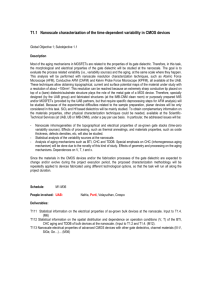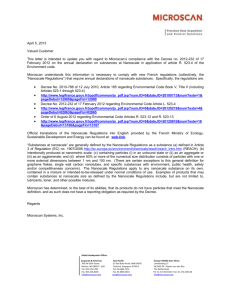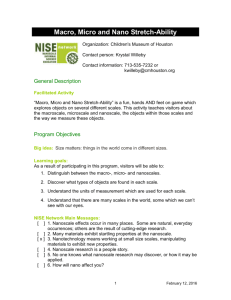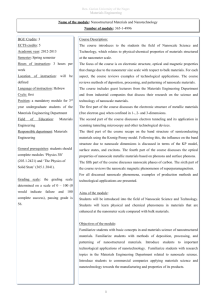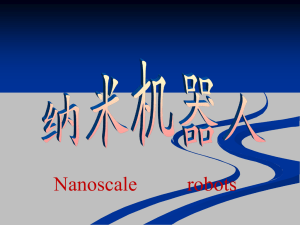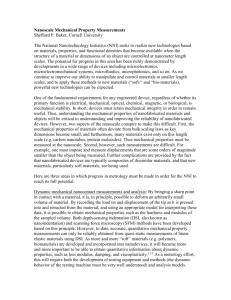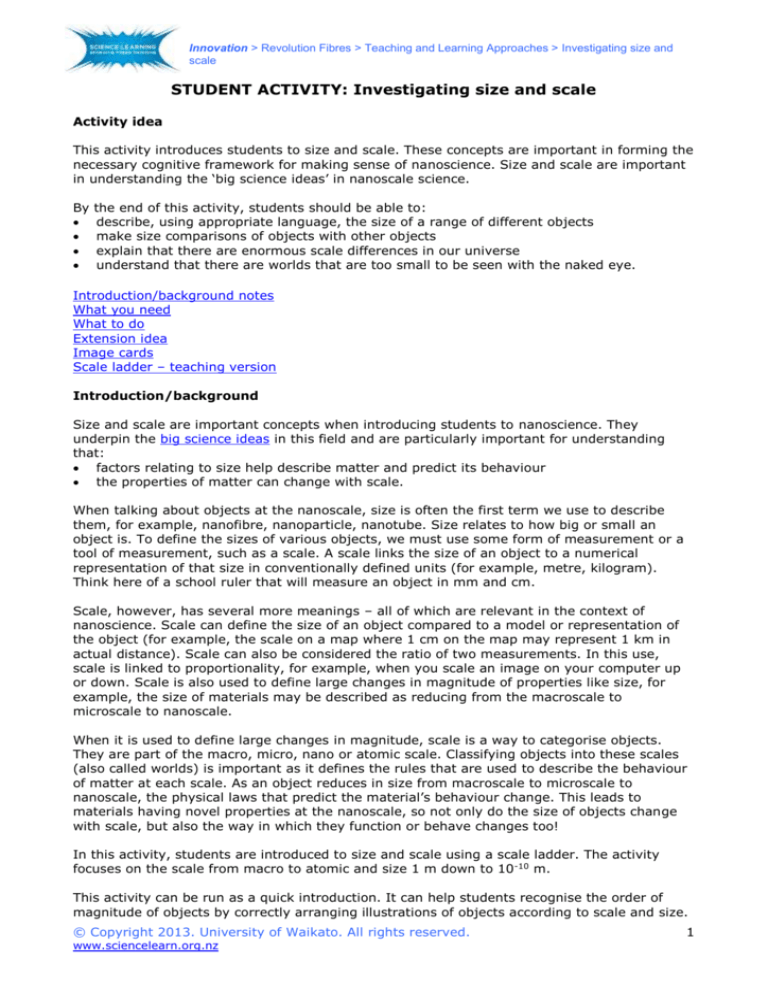
Innovation > Revolution Fibres > Teaching and Learning Approaches > Investigating size and
scale
STUDENT ACTIVITY: Investigating size and scale
Activity idea
This activity introduces students to size and scale. These concepts are important in forming the
necessary cognitive framework for making sense of nanoscience. Size and scale are important
in understanding the ‘big science ideas’ in nanoscale science.
By
the end of this activity, students should be able to:
describe, using appropriate language, the size of a range of different objects
make size comparisons of objects with other objects
explain that there are enormous scale differences in our universe
understand that there are worlds that are too small to be seen with the naked eye.
Introduction/background notes
What you need
What to do
Extension idea
Image cards
Scale ladder – teaching version
Introduction/background
Size and scale are important concepts when introducing students to nanoscience. They
underpin the big science ideas in this field and are particularly important for understanding
that:
factors relating to size help describe matter and predict its behaviour
the properties of matter can change with scale.
When talking about objects at the nanoscale, size is often the first term we use to describe
them, for example, nanofibre, nanoparticle, nanotube. Size relates to how big or small an
object is. To define the sizes of various objects, we must use some form of measurement or a
tool of measurement, such as a scale. A scale links the size of an object to a numerical
representation of that size in conventionally defined units (for example, metre, kilogram).
Think here of a school ruler that will measure an object in mm and cm.
Scale, however, has several more meanings – all of which are relevant in the context of
nanoscience. Scale can define the size of an object compared to a model or representation of
the object (for example, the scale on a map where 1 cm on the map may represent 1 km in
actual distance). Scale can also be considered the ratio of two measurements. In this use,
scale is linked to proportionality, for example, when you scale an image on your computer up
or down. Scale is also used to define large changes in magnitude of properties like size, for
example, the size of materials may be described as reducing from the macroscale to
microscale to nanoscale.
When it is used to define large changes in magnitude, scale is a way to categorise objects.
They are part of the macro, micro, nano or atomic scale. Classifying objects into these scales
(also called worlds) is important as it defines the rules that are used to describe the behaviour
of matter at each scale. As an object reduces in size from macroscale to microscale to
nanoscale, the physical laws that predict the material’s behaviour change. This leads to
materials having novel properties at the nanoscale, so not only do the size of objects change
with scale, but also the way in which they function or behave changes too!
In this activity, students are introduced to size and scale using a scale ladder. The activity
focuses on the scale from macro to atomic and size 1 m down to 10 -10 m.
This activity can be run as a quick introduction. It can help students recognise the order of
magnitude of objects by correctly arranging illustrations of objects according to scale and size.
© Copyright 2013. University of Waikato. All rights reserved.
www.sciencelearn.org.nz
1
Innovation > Revolution Fibres > Teaching and Learning Approaches > Investigating size and
scale
It can also be used to increase familiarity with the metric system, scientific notation and
common SI prefixes.
Finally, it can be used to introduce students to the idea that the rules of physics change as the
scale and size of an object changes and that this leads to materials with novel properties at the
nanoscale.
What you need
Image cards – printed out or use on digital whiteboard
Access to the teaching version of the scale ladder – printed out or use on digital whiteboard
Access to the image Scale ladder – from macro to atomic – printed out or use on digital
whiteboard
What to do
1. Begin by exploring with your class what are the largest objects and smallest objects they
can think of anywhere/in your school/in your classroom and list these objects on the board.
2. Organise students into groups and give each group a set of image cards. Ask them to
group the objects into those that you can see and those that can’t. (You might want to
include images of the objects your class listed in step 1 as well.)
3. Introduce the class to the teaching version of the scale ladder. Explain how objects can be
grouped into scales – macro, micro, nano, atomic – and while you are able to see some
objects with your eyes, many objects are too small and you need to use special tools (light
microscope, electron microscope, atomic probe microscope).
4. Ask students to group the objects on the cards into macro, micro, nano and atomic scales.
Check with each group that their cards are grouped correctly. Use the image Scale ladder –
from macro to atomic as a reference.
5. Ask each group to order the cards from largest to smallest.
6. Investigate relative scale by asking how large objects are in relation to each other. For
example, which is bigger: an atom, a molecule or a virus?
7. Allocate each group a scale – macro, micro or nano – and ask them to research to find 3–5
other objects that are examples for their scale. Students may like to use an online scale
interactive or scale app for some of this research (see the Science Learning Hub’s Pinterest
board Investigating size and scale).
8. Create a record of these objects (for example, draw, list, print out image, copy image into
PowerPoint or whatever is appropriate for your class).
9. Bring the groups together to hear what objects each group has found. Discuss how each
object could be described (for example, as part of the microscale, as x mm diameter, only
seen with a microscope, 10 times bigger than x, bigger than z, smaller than y and so on).
Extension idea
Novel properties at nanoscale
Researchers and scientists are interested in nanoscale materials because, as materials are
reduced to nano size, they start to behave differently and novel properties emerge. As objects
reduce in size, the physical laws that predict the material’s behaviour change – moving from
classical mechanics to quantum mechanics.
© Copyright 2013. University of Waikato. All rights reserved.
www.sciencelearn.org.nz
2
Innovation > Revolution Fibres > Teaching and Learning Approaches > Investigating size and
scale
The unexplored potential of these new properties and how they lead to new and different uses
makes nanomaterials exciting to work with. You might like to explore this in more detail with
your class:
Read the article Novel properties emerge at the nanoscale and discuss the examples of
novel properties in nanoscale materials and how new applications are being found for these
materials.
Research online to find out other examples of how the properties and behaviours of
materials change at the nanoscale, for example:
o gold – at the macroscale, gold is easily recognisable for its colour, but at the
nanoscale, gold particles appear red or purple; at the macroscale, gold has a
melting point of 1064°C, but at the nanoscale, the melting point of gold reduces by
about 100°C
o aluminium – at the macroscale, aluminium is an inert, shiny pliable metal used to
make cans, but at the nanoscale, aluminium particles are extremely reactive and
will explode
o zinc oxide – at the macroscale, this is an ingredient in some sunblocks that gives it
a white colour, but at the nanoscale, zinc oxide particles appear transparent and the
sunblock is clear.
© Copyright 2013. University of Waikato. All rights reserved.
www.sciencelearn.org.nz
3
Innovation > Revolution Fibres > Teaching and Learning Approaches > Investigating size and
scale
© Copyright 2013. University of Waikato. All rights reserved.
www.sciencelearn.org.nz
4
Innovation > Revolution Fibres > Teaching and Learning Approaches > Investigating size and
scale
© Copyright 2013. University of Waikato. All rights reserved.
www.sciencelearn.org.nz
5
Innovation > Revolution Fibres > Teaching and Learning Approaches > Investigating size and
scale
© Copyright 2013. University of Waikato. All rights reserved.
www.sciencelearn.org.nz
6


